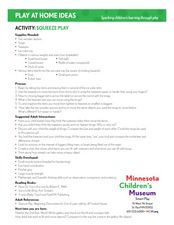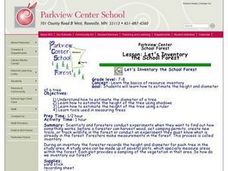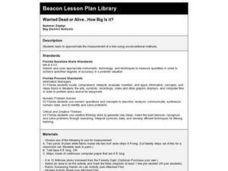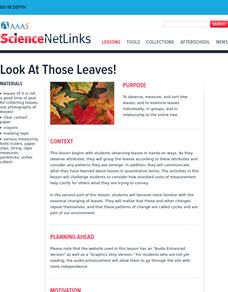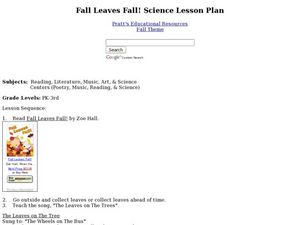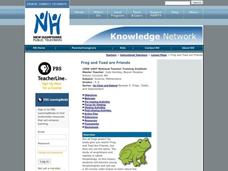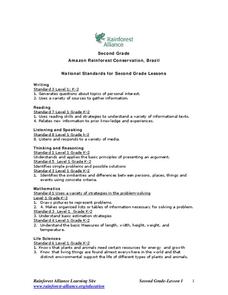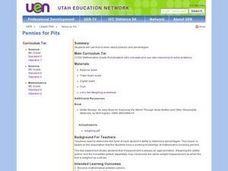Curated OER
Squeeze Play
Young scientists demonstrate how to move objects. In this fine motor lesson, students use various objects such as dice, erasers, and soft balls and move them using the proper device.
Washington Office of Superintendent of Public Instruction
Using Our Senses to Observe
Look around and explore. Little ones use their five senses with some day-to-day activities designed to guide observation and apply STEM strategies. Young scientists learn through comparing/contrasting and...
Curated OER
LET'S INVENTORY THE SCHOOL FOREST
Students study how to estimate the diameter of a tree, estimate the height of the tree using shadows, estimate the height of the tree using a ruler, and use tools for measuring trees.
Curated OER
Wanted Dead or Alive...How Big Is it?
Fourth graders estimate the measurements of trees using unconventional techniques.
Curated OER
Look At Those Leaves!
Learners observe, measure, and sort tree leaves. They examine leaves individually, in groups, and in relationship to the entire tree. They become familiar with the seasonal changing of leaves. They realize that these and other changes...
Curated OER
Study Buddies: Explore - Area
In this math worksheet, students will work with a coach to find the total area of a tree-house. Students will follow a step-by-step process and notes are provided for the coach.
Curated OER
Weather History
Students study how weather is measured. In this climate lesson plan, students research how samples of the ocean floor reveal facts about the climate thousands of years ago. Students use clay samples to create layers that simulate real...
Curated OER
Topo Triangulation
Students investigate how to read a topographical map and triangulate with just a map. They convert a compass measurement to a protractor measurement, reverse a bearing direction, and using a worksheet take a bearing of certain landmarks...
Curated OER
Warming by Freezing
Ninth graders discover the reasoning behind spraying water on fruit and seedlings in preparation for hard freezes. In this conceptual physics lesson, 9th graders conduct an experiment to measure the heat released when water goes from a...
Curated OER
Fall Leaves Fall
Students explore fall leaves. For this leaf lesson, students collect leaves to investigate. Students also measure, compare and contrast, draw and look at leaves through a magnifying glass. Students sing songs and use movement in this...
Curated OER
How Big is a Breath?
Students demonstrate how to use math skills to measure their lung capacity. In this human biology lesson, students use a clear plastic container, measuring cup and rubber balloons to demonstrate how the lungs work. Students estimate the...
Curated OER
Circumferences, Diameters, and Radii
Young scholars explore circumferences, diameters, and radii. In this math lesson plan, students measure circumferences in inches and compute radii and diameters, given different circumferences.
Curated OER
A Tough Nut to Crack
Children, based on a set of criteria, evaluate the quality of pecans. They research recorded history of pecan trees as well as how their seeds moved across western Missouri into southeastern Kansas, Oklahoma, Texas and Mexico. In...
Curated OER
GPS Ecosystem (Ecotone) Scavenger Hunt
High schoolers describe the characteristics of an ecotone. In this ecotone lesson plan, students pick out their area and describe the visual appearance, conditions, ecosystem, biodiversity, predators, prey, and trees in their ecotone....
Curated OER
Frog and Toad are Friends
Students view a 30-minute video activity to discover information about the characteristics of frogs and toads. They then transform themselves into frogs and participate in a Jumping Frog Jubilee. They work in groups of three to measure...
Curated OER
Freshwater Habitats
Learners take samples from local freshwater sources and examine them for macroinvertebrate life. They take samples from both shallow and deep freshwater environments, measure temperatures, and classify organisms found in their samples.
Curated OER
Schoolyard Geology
Discover that maps show information about an area and that they have common features like scales and legends. View an aerial map of your school and find features on the map such as the playground, roads, and trees. Trace the outline of...
Curated OER
Which Way Is North?
Students investigate the concept of finding locations with the use of a compass and a map. They practice the skill of bearing and set up courses of travel to different destinations around the school grounds. Students also practice taking...
Curated OER
Plants and the Water Cycle
Students study the role of plants in recycling water by collecting water vapor that is emitted, or transpired, by green plant leaves. They collect and measure the water that transpires through the tiny pores of plant leaves. Afterwards,...
Curated OER
Amazon Rainforest Conservation, Brazil
Students explore rain forests. In this rain forest lesson, students participate in a "BioBlitz" of their schoolyard, observing and recording every living thing in a designated area. Students visit websites about rain forests...
Curated OER
Creeping and Crawling Observing Mealworms and Earthworms
Students observe the inherited traits in earthworms and mealworms. In this organisms lesson, students view a live mealworm and earthworm on a tray and identify the body parts. Students measure the worms and observe the behavior....
Curated OER
Look at Those Leaves!
Students observe and sort tree leaves. For this plant biology lesson, students observe various types of leaves and identify the characteristics of each leaf. Students measure and sort leaves according to size and color.
Curated OER
International Festival: Japan
Students discover Japanese culture and the importance of Sakura to Japan. In this international festival instructional activity, students demonstrate an appreciation for the Sakura trees beauty by creating Sakura trees from white and...
Curated OER
Pennies for Pits
Sixth graders use the edible and nonedible parts of various fruits to determine percentages. Using measurements and appropriate tools are part of the instructional activity.
